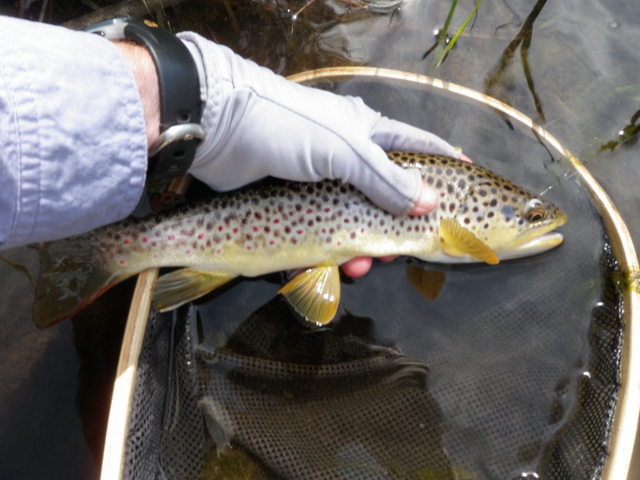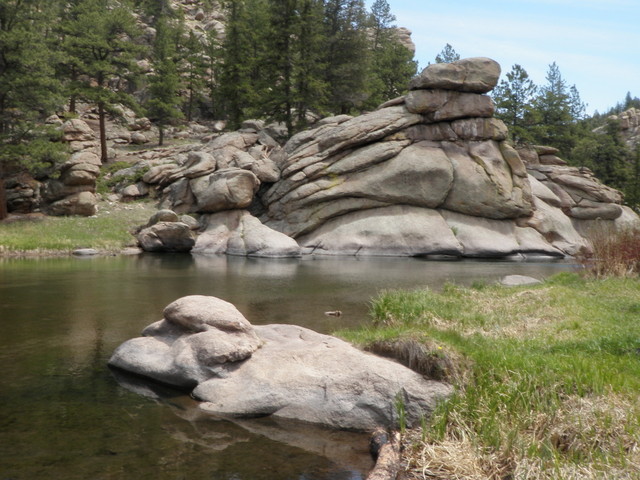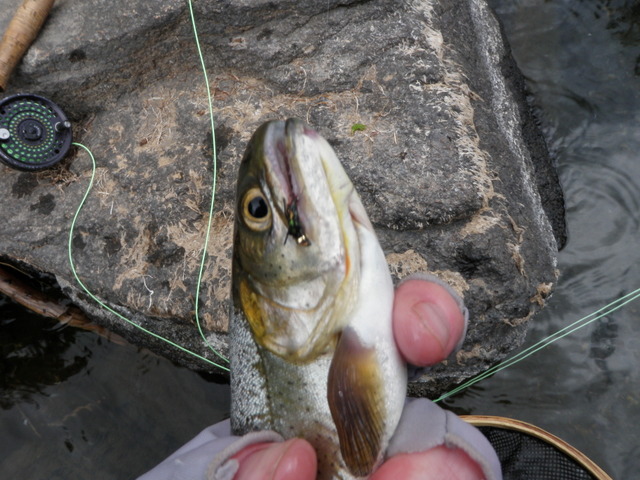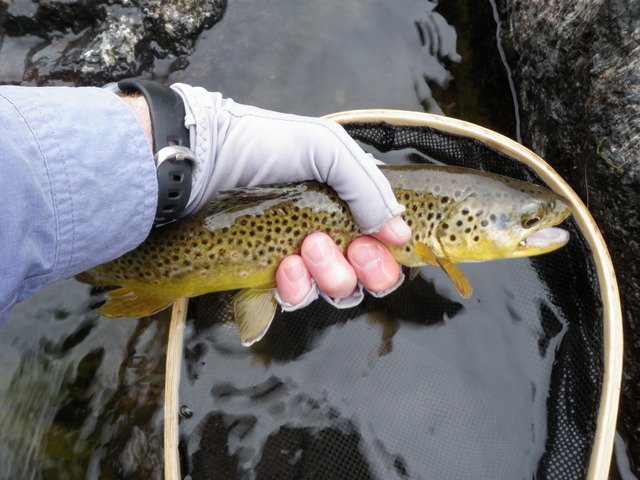Time: 9:30AM – 4:30PM
Location: Below first bridge after Springer Gulch and then upstream from huge pool below wide pullout up to the twin tunnels
Fish Landed: 6
South Platte River 05/29/2014 Photo Album
May 29 is very late in the runoff time period to think about fishing in a Colorado river, but that is what I did on Thursday. With epic volumes of water tumbling down rivers and streams in Colorado, the South Platte River in Eleven Mile Canyon remains at 75 cfs. In addition the South Platte below Cheesman Reservoir near Deckers was holding steady at 100 cfs, however, this stretch of river had been running at 400 and only recently plunged to the 100 level. I am not a fan of fishing rivers that experience recent significant changes, so I decided to pay Eleven Mile Canyon a visit.
The weather forecast for Denver was a high of 88 degrees with a small chance of afternoon thunderstorms. I translated this to highs in the low 70’s in Eleven Mile Canyon. I paid my day use fee to a lady at the entrance station, and she complimented my music selection. I had a Monkees and Four Seasons playlist blasting on my radio, and she appeared to be in my age bracket. The dashboard temperature registered 59 degrees when I arrived at the pullout .2 miles below the first bridge above Springer Gulch Campground, but the sun was bright so I elected to forego any extra layers.
When I was prepared, I walked down the path a bit to the second nice run and pool below the car; however, as I moved toward the water, a father and son appeared. Clearly I was there first, but I decided to surrender the bottom pool to the father and son team and moved upstream to the next juicy pool. The water was as advertised; clear and flowing at 75 cfs. A bit more volume would be welcome, but I was more than willing to accept somewhat low flows given the condition of the other rivers in the state. I tied on a Chernobyl ant and beadhead hares ear and began to prospect the wide angled run and pool in front of me. I noticed several refusals by a fish in the seam along the center run, but nothing was showing interest in my hares ear. I noticed two random rises as I was covering the water, and the only insect I could conceive of being on the water in the morning was a midge.
I pulled up my line and added an 18 inch section of tippet to the eye of the hares ear and tied on a zebra midge. Finally on a drift along the seam on the right side, the Chernobyl ant paused and I set the hook and felt the weight of a decent fish. The trout began to streak toward the middle of the run and then reversed back to its original location. I held tight, but after a couple aerial maneuvers where I could see the trademark pink stripe of a rainbow, it made a quick turn, and my hook came free. I’m guessing the tiny zebra midge was the food of choice for the hungry rainbow, but I’ll never know for sure. I could hear the father and son moving closer behind me, so I moved above the attractive pool and began exploring pockets and smaller runs.
It didn’t take too long before I hooked and netted an eleven inch brown on the hares ear nymph, and I photographed this fish as I wasn’t sure how many more I’d entice to my net. The next stretch was wide and shallow with a series of manmade deadfalls anchored on angles to create more structure; but in spite of this effort, the fish holding locations were minimal.
I was bothered by the refusals to the Chernobyl ant, and I wondered if something more sparse might provoke surface takes, so I tied on a yellow Letort hopper. I fished this for a bit, and it became waterlogged so I brought it in and sopped up the moisture absorbed by the body on my shirt sleeve. Next as is my custom, I searched for my dry shake canister to give it a dunking, but I was disappointed to discover that the green canister was upside down with the lid open. The vial was empty, and I was now stressed as dry shake is an essential ingredient to dry fly fishing.
With the newfound knowledge that I was handicapped by the absence of dry shake, I decided to convert to a nymphing configuration. I converted to a strike indicator, small split shot and two flies. At least under this method the fish could not refuse my top fly, and I didn’t need dry shake. I stayed with the beadhead hares ear and added a RS2 and ran these flies through some juicy deep runs but once again to no avail. I swapped the RS2 for a soft hackle emerger at some point, but my fortunes remained the same.
After covering a nice run and a couple small pockets with no success I encountered a trio of fishermen that entered the river from above. It was around 11:45 so I decided to use this as an opportunity to exit, and I returned to the Santa Fe.
I decided to move upstream to search for another location with some room to move, and a half mile further along, where there is a huge wide pullout high above the river, I found such a place. I grabbed my lunch bag and water bottle and very carefully descended the rocky path. The river narrowed right below the car and created a huge white water cascade, but above the narrow chute was a huge wide clear pool that extended forty yards further upstream. I sat by the water and ate, and during a lull in the breeze when the water was clear, I spotted a group of four brown trout slowly moving along in the slow shelf water. They were occasionally plucking tiny morsels from the drift, and every once in a while one would slowly fin to the surface and sip something extremely tiny.
This didn’t last long however as the breeze resumed, and my vision could no longer penetrate the riffled surface of the pool. Once I finished my lunch, I carefully climbed to the road and returned to the car for my rod and gear. I decided that the smooth pool was too technical and likely would lead to hours of frustration, so I moved to the head of the pool. Also my rod was still rigged with the nymphs, and I wasn’t anxious to invest the necessary time to convert back to dry flies to make the delicate casts required by the smooth pool.
I began to prospect the nice pools and runs above the large pool, but I was losing confidence quickly. By now the sun was high in the clear blue sky, and I was feeling quite warm and sluggish. I suspect the trout were in a similar state, but I continued on hoping that something would change my fortunes. It didn’t take long for change to come in the form of another fisherman ahead of me. I decided to make a big loop around him and cut back to the worn path on the bank and circled above him to some more nice pocket water.
By now the nymphs were out of favor, so I clipped them off and removed the indicator and split shot and returned to my favorite dry/dropper technique. I tied a yellow pool toy to my line as the buoyant indicator fly and below that I added a beadhead hares ear and then knotted a salvation nymph below the hares ear as my third offering. I quickened my pace and resolved to no longer dwell in one spot even if I spotted fish or experienced a refusal.
This paid dividends as I landed four more fish over the remaining two hours of fishing. Number three was a pretty bronze cutthroat with the trademark slash under its jaw, and this fish snatched the salvation nymph at the tail of a run. One of the last three fish was a rainbow and the other two were browns, and they all found the salvation nymph to their liking. By three o’clock some large gray clouds appeared on the western horizon and this seemed to improve the fishing. The temperature dropped and a breeze picked up, and I carefully looked for blue winged olives. I spotted two or three over the course of a half hour and switched the salvation nymph for the soft hackle emerger, but this had minimal impact on my success. After a solid trial period I abandoned this dose of over-analysis and reverted back to the salvation nymph, and I was rewarded with the three fish I described previously.
Late in the afternoon I bumped into another pair of fishermen and executed another bank detour to get above them. It was during the last hour of the day that I encountered a second muskrat that surfaced near my left leg, and then I spotted a small creature scurrying along the rocks to my left. It was a small slender animal with a long tail, light brown fur, and a round face with small round ears. I’m guessing it was some sort of weasel or mink, but I always imagined these animals to be much darker in color.
Finally I approached another beautiful long pool and another young fisherman was above me; however, he seemed to tire of the area he was fishing and moved to the top more than fifty yards above me. I began casting the pool toy and trailing nymphs to the tail of the pool, but as I did this I began to observe several surface rises. The surface disturbances were spread out and not repeated by the same fish. I was going to quit in a half hour, and the other fisherman blocked my path upstream to water more appropriate for dry/dropper fishing, so I decided to commit to dry fly fishing. When I waded to the tail of the pool I could see quite a few decent fish hanging in the current, but in addition there were at least five or six large suckers huddled in the trough ahead of me. I’d seen groups of suckers earlier in the day, and I wondered if they were spawning, and what sucker eggs look like.
With more rises scattered about the pool I decided to try a CDC BWO even though I didn’t see any riding on the surface of the river. After quite a few unproductive casts of the blue winged olive imitation, I changed to a gray deer hair caddis. This fly actual induced a few looks and a solid refusal as a brown swirled at the surface in front of the fly, but did not suck it in. Next I resorted to an olive caddis with the thought that perhaps the body color was off a bit. Again the fish rejected my theory, and finally I tied on a fur parachute ant. This fly prompted some casual looks, but no takes until I finally declared the fish winners and found a steep exit path.
It was a fun day in spite of my relatively low catch rate. I spotted quite a few fish and experimented with numerous approaches. I never fully solved the riddle, but did manage to land a few fish on a splendid late spring day on the South Platte River.




